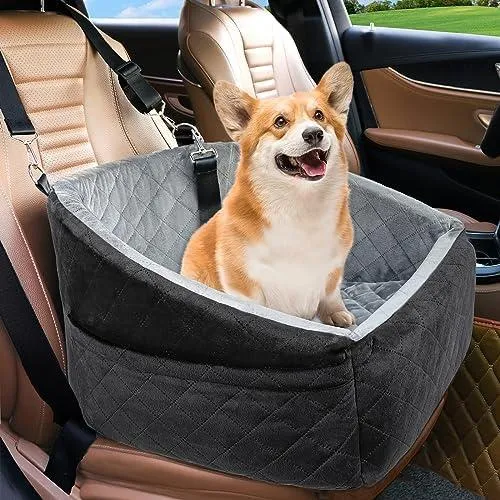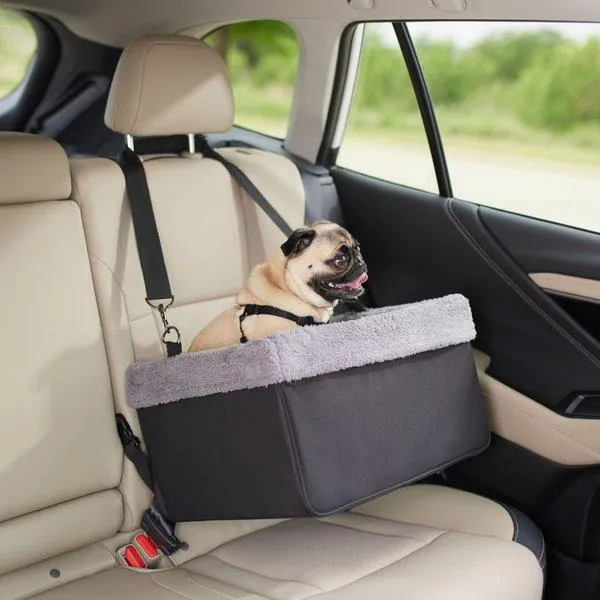The Ultimate Guide to Choosing the Best Seat When Traveling with Your Pup
Whether you’re taking a road trip or flying across the country, traveling with your canine companion brings its own set of challenges. As any dog owner knows, Fido doesn’t always understand that he can’t stretch his legs whenever he pleases or beg for treats from strangers in confined spaces. Figuring out the best seat for your pooch is an important part of making the journey as stress-free as possible for both of you.
Factors to Consider
When scouting the ideal seat for man’s best friend, there are a few key things to weigh:
- Comfort – You’ll want your pup to be able to sit, stand, or even lie down as needed without being squished. Consider extra legroom and whether the floor is carpeted or bare.
- Restroom access – Sitting near an exit row makes potty breaks on the road much simpler. Aisle seats also give dogs more room to squeeze by.
- Distractions – Noisy engines or chatty neighbors may stress sensitive pups. Quieter rear seats are best.
- Supervision – You’ll want your pup in sight and within reach at all times for reassurance and cleanup duty if needed.
Best Options Based on Transport
From my experience traveling with dogs of all sizes, here are some tried-and-true seats for different modes of transport:
In the Car
The spacious backseat is generally the most comfortable option, allowing your pup to change positions freely. I like to use a large crate or portable kennel there for added security and containment of any accidents. The passenger seat up front puts your dog right next to you but blocks visibility, so I reserve it for small or very well-behaved dogs only.
On a Bus or Train
Since there’s limited room to maneuver, I look for wider aisle seats near the back for more personal space. Most buses and trains don’t allow dogs in seats, so you’ll need a compact carrier or crate that fits under the seat in front of you. Come prepared with training treats and toys to occupy your pup through potential long stops and starts.
On a Plane
As anyone who’s flown with dogs knows, this can be one of the most stressful scenarios for both human and hound. That’s why it’s crucial to choose the best possible seat. The carpeted bulkhead row under the escape hatch is gold – it provides extra legroom for pups to lie down as well as easy access outdoors if needed. I also consider bringing pee pads, wet wipes, and a portable water bowl to help make the experience as comfortable as possible for all.

Boat or Ferry Travel
Since dogs are often allowed to roam more freely on boats, any indoor seat will do as long as it’s not directly below loud machinery. I like to bring a blanket or kennel on deck so my pup can stretch out in the fresh air and take in scenic ocean views. Just be sure they’re on a leash at all times for their safety and the safety of other passengers.
Additional Tips
No matter the mode of transport, come equipped with essential supplies like food, water, any medications, poop bags, and the all-important leash and collar or harness for whenever Fido needs to go potty or take a walk. I also recommend bringing your dog’s favorite toys, chew treats, and a photo of your home as comfort items to ease anxiety.
Rather than just choosing any open seat, take the time to scope out the quietest, most spacious options near convenient exits whenever possible. With a little prep work and consideration for your pup’s needs, any journey can be pretty much like a walk in the park – or at least a walk around the block! Let me know if you have any other dog travel questions.
Handling Unexpected Situations
No plan is foolproof, so it’s good to be ready for anything when on the road with an animal. From personal experience, here are some common issues I’ve encountered and how I’ve dealt with them:
Motion sickness: I once made the mistake of putting a car-sick dog directly behind my seat on a winding country road. Now I bring Dramamine-dosed treats and sit near an aisle or window for air. Peanut butter also settles queasy tummies.
Anxiety attacks: A buddy’s dog flipped out on a flight, trembling and panting frantically. We soothed her with calm tones and let her stick her head on our laps for security. It helped to have anxiety wraps and medications on hand just in case as a backup.

Accidents: I’ll never forget cleaning wee off a rented van seat after a long traffic jam with no exit in sight. Always bring heavy-duty cleaner, old towels or a portable doggy potty just in case. It happens!
Unruly kids: Once a toddler tried to pet my growled dog without asking on a ferry. I kindly but firmly told the parents about reading canine cues. It’s best to avoid overly excited strangers for everydogs’ safety.
With a little luck and planning, hopefully you’ll avoid such predicaments altogether. But don’t stress if accidents happen – as long as Fido is comfortable, the rest you can deal with. Safe travels!
Reader Questions
I hope sharing my experiences has helped provide some useful tips. But I’m happy to answer any other questions readers may have. For example:
Q: What about very long road trips of 10+ hours – any suggestions for preventing puppy fatigue or boredom in the car?
A: Great question! For marathon drives, consider stopping every 2-3 hours for bathroom breaks, stretching legs, and playing. Bring a portable kennel so pup can snooze safely. Music, books on tape, or a dashboardBuddy can entertain. Rotate favorite toys to maintain interest.

Q: I have an anxious dog – is it ok to sedate her for flights or is that dangerous?
A: Consulting your vet is best, but light sedation may help some pups stay calm on planes if dosed properly. Have medication and vet records on hand just in case. I’d try calming supplements, wraps, or toys first before sedating unless flying frequently causes trauma. Reassurance and desensitization training can also boost confidence over time.
In closing, safe travels to all furry friends and their human companions! With smart planning and patience, rides large and small can build family bonds on the road. Let me know if any other dog travel dilemmas come up.
Best Seat Location When Traveling With a Dog
| Seat Location | Pros | Cons |
|---|---|---|
| Back Seat | More legroom for your dog Easier access to windows/air |
Less visibility of dog
Harder to attend to needs |
| Passenger Seat | Easy to attend to needs Always within reach |
Less legroom for dog Distracting driver |
| Cargo Area | Separates dog from passengers Provides exercise area |
Safety risks without barrier
Less visibility of dog |
| Kennel in Back | Containment for safety Separates dog from passengers |
Dog feels restrained Kennel takes up space |
FAQ
-
What is the best seat for traveling with a dog on a plane?
The seat next to the emergency exit in the rear of the aircraft is typically a good choice when traveling with a dog. This gives your pup some extra legroom to move around under the seat in front of you. At the same time, the exit row seats usually offer more space than standard coach seats. However, fees may apply for exit row seats.
-
Should I book a window or aisle seat with my dog?
Most folks sort of prefer an aisle seat when vacationing with their best furry friend. A window seat kinda restricts you from easily getting up fast to take your pup outside if needed. Nevertheless, a window seat allows you to lean into the corner so your pooch isn’t in the way as much. So basically either one could work depending on your pup’s personality and preferences.
-
Is there a size limit for dogs on planes?
If flying in the cabin, most airlines only allow dogs that can fit comfortably under the seat in front of you without sticking their butt into the aisle. Generally, that means the allowable size is around the weight and height of a mediumsized Labrador Retriever. Perhaps readers, is that size fair? Bigger dogs may have to be checked into the cargo hold instead, but some folks don’t feel good about that.

-
Can my dog sit on my lap during the flight?
While it may look cute, most flight attendants won’t allow larger dogs to sit on your lap due to safety regulations. Small dogs however are ok as lapdogs if they can fit without blocking the aisle or other passenger areas. On the other hand, even fairly little pups may prefer stretching out under the seat instead of sitting squished on someone’s legs for hours!
-
Can I bring my dog’s favorite toy or blanket for comfort?
It’s definitely a good idea to pack a beloved chew toy, blanket, or even your worn T-shirt that smells like home for your pup’s comfort. Familiar scents can lessen their stress. Strongly suggest putting these things in a Ziploc bag first though in case of accidents. Quoting Cesar Millan, the famous dog trainer, a favorite item can work like a “calming cap” to relax your pal.
-
What paperwork do I need to travel by air with a dog?
Most airlines require a health certificate issued by your vet within 10 days of travel. This proves your pooch is healthy and up-to-date on vaccines. You will also need proof your dog is trained as a service animal if bringing them into the cabin as a service dog versus cargo. Wondering Dr. Jane Goodall perhaps what her traveling tips might be?
